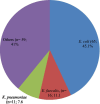Urinary tract infection among people living with human immunodeficiency virus attending selected hospitals in Addis Ababa and Adama, central Ethiopia
- PMID: 39296834
- PMCID: PMC11408745
- DOI: 10.3389/fpubh.2024.1394842
Urinary tract infection among people living with human immunodeficiency virus attending selected hospitals in Addis Ababa and Adama, central Ethiopia
Abstract
Background: Urinary tract infections (UTIs) and antibacterial resistance (ABR) are important public health problems, but they are not well-studied among people living with human immunodeficiency virus (PLHIV) globally, especially in low-income countries. Therefore, it is important to regularly measure the extent of UTIs and ABR in the most susceptible populations. This study aimed to investigate the prevalence of UTIs, associated factors, bacterial causal agents, and their antibiotic susceptibility profile among PLHIV in central Ethiopia.
Methods: A hospital-based cross-sectional study was conducted to recruit 688 PLHIV by a simple random sampling method. Background information was gathered through interviews, while clinical information was gathered from recent information sheets of patient charts using organized, pretested, and validated study tools. Midstream urine was collected aseptically and transported to the Microbiology Laboratory of Aklilu Lemma Institute of Pathobiology within 4 h of collection, maintaining its cold chain. Standard conventional microbial culture methods and matrix-assisted laser desorption ionization-time of flight (MALDI-TOF) mass spectrometry were used to identify the bacterial isolates at the species level. Kirby Bauer's disk diffusion method was used to determine the antibiotic susceptibility profile of the bacterial isolates based on the interpretation guidelines of the Clinical Laboratory Standard Institute. Logistic regression models were used to examine factors associated with the occurrence of UTIs among PLHIV attending selected hospitals in Addis Ababa, and Adama.
Results: Out of 688 PLHIVs involved in the current study, 144 (20.9%) were positive for UTIs, whereas the majority were asymptomatic for UTIs. In the multivariable logistic regression analysis, only HIV RNA ≥ 200 copies/ml [AOR = 12.24 (95% CI, 3.24, 46.20), p < 0.01] and being symptomatic for UTIs during the study period [AOR = 11.57 (95% CI, 5.83, 22.97), p < 0.01] were associated with the occurrence of UTIs. The dominant bacterial species isolated were Escherichia coli (E. coli; n = 65; 43%), followed by Enterococcus faecalis (E. faecalis; n = 16; 10.6%) and Klebsiella pneumoniae (K. pneumoniae; n = 11; 7.3%). Over half of the E. coli isolates were resistant to antibiotics such as gentamicin (GM; n = 44; 67.7%), amikacin (AN; n = 46; 70.8%), nalidixic acid (NA; n = 42; 64.6%), ciprofloxacin (CIP; n = 40; 61.5%), and azithromycin (AZM; n = 45; 69.2%). All of the K. pneumoniae isolates (n = 11; 100%), (n = 6; 54.5%), and (n = 7; 63.6%) were resistant to [amoxicillin as well as amoxicillin + clavulanic acid], ceftriaxone, and sulfamethoxazole + trimethoprim, respectively. All the Staphylococcus aureus (S. aureus) isolates were resistant to cefoxitin, which implies methicillin-resistant S. aureus (MRSA).
Conclusion: The high prevalence of UTIs and antibiotic resistance revealed in the current study needs public health interventions such as educating the population about preventive measures and the importance of early treatment of UTIs. Our findings also highlight the need to provide UTI screening services for PLHIV, and healthcare providers should adopt antibiotic stewardship programs to promote and ensure their appropriate and judicious use.
Keywords: Ethiopia; antibacterial resistance; bacterial uropathogens; human immunodeficiency virus (HIV); urinary tract infections (UTIs).
Copyright © 2024 Gebremedhin, Yisma, Alemayehu, Medhin, Belay, Bopegamage, Amogne and Eguale.
Conflict of interest statement
The authors declare that the research was conducted in the absence of any commercial or financial relationships that could be construed as a potential conflict of interest.
Figures

Similar articles
-
Antimicrobial susceptibility patterns of urinary tract infections causing bacterial isolates and associated risk factors among HIV patients in Tigray, Northern Ethiopia.BMC Microbiol. 2024 Apr 27;24(1):148. doi: 10.1186/s12866-024-03297-2. BMC Microbiol. 2024. PMID: 38678188 Free PMC article.
-
BACTERIAL PROFILE, ANTIMICROBIAL RESISTANCE, AND FACTORS ASSOCIATED WITH URINARY TRACT INFECTION AMONG PREGNANT WOMEN AT HOSANNA TOWN HEALTH FACILITIES, CENTRAL ETHIOPIA.Georgian Med News. 2023 Sep;(342):113-121. Georgian Med News. 2023. PMID: 37991965
-
Asymptomatic bacteriuria and symptomatic urinary tract infections (UTI) in patients with diabetes mellitus in Tikur Anbessa Specialized University Hospital, Addis Ababa, Ethiopia.Ethiop Med J. 2012 Jul;50(3):239-49. Ethiop Med J. 2012. PMID: 23409407
-
Sulopenem: An Intravenous and Oral Penem for the Treatment of Urinary Tract Infections Due to Multidrug-Resistant Bacteria.Drugs. 2022 Apr;82(5):533-557. doi: 10.1007/s40265-022-01688-1. Epub 2022 Mar 16. Drugs. 2022. PMID: 35294769 Review.
-
Urinary tract infections: pathogenesis, host susceptibility and emerging therapeutics.Nat Rev Microbiol. 2025 Feb;23(2):72-86. doi: 10.1038/s41579-024-01092-4. Epub 2024 Sep 9. Nat Rev Microbiol. 2025. PMID: 39251839 Review.
Cited by
-
Prevalence, Risk Factors and Antimicrobial Resistance of Enterococci caused Urinary Tract Infection among People Living with HIV in Addis Ababa, Ethiopia.Niger Med J. 2025 Jun 16;66(2):657-668. doi: 10.71480/nmj.v66i2.635. eCollection 2025 Mar-Apr. Niger Med J. 2025. PMID: 40703884 Free PMC article.
References
-
- Amaya-Tapia G, Ibarra-Nieto G, Rivas OC, Sánchez JLG. Urinary tract infection in HIV/AIDS patients In: Hegazy DW, El FDAA, Lwegasila DLJ, editors. Urinary tract infections. Rijeka: IntechOpen; (2023)
-
- Tessema NN, Ali MM, Zenebe MH. Bacterial associated urinary tract infection, risk factors, and drug susceptibility profile among adult people living with HIV at Haswassa university comprehensive specialized hospital, Hawassa. Southern Esthiopia Scientific Reports. (2020) 10:10790. doi: 10.1038/s41598-020-67840-7, PMID: - DOI - PMC - PubMed
MeSH terms
Substances
LinkOut - more resources
Full Text Sources
Medical

